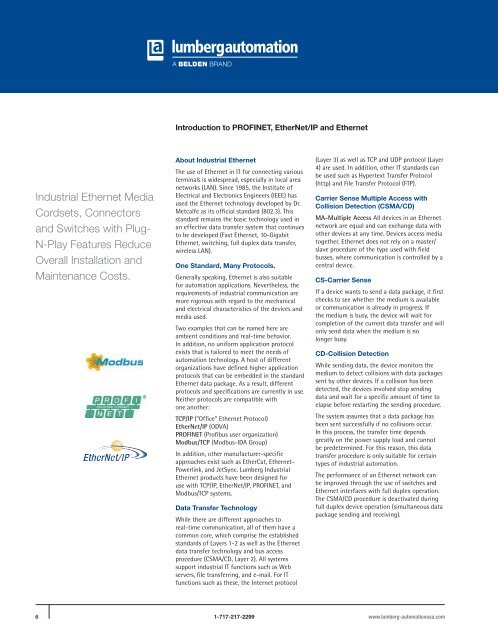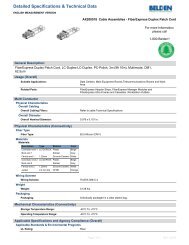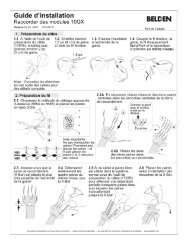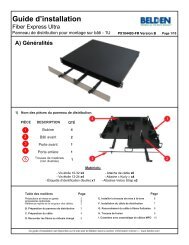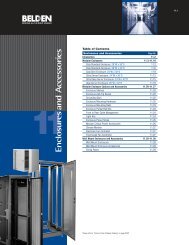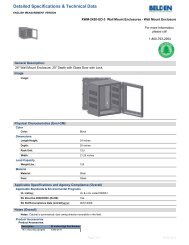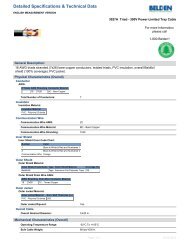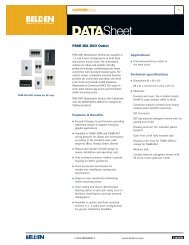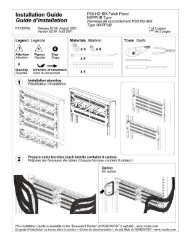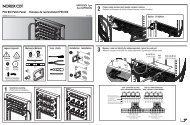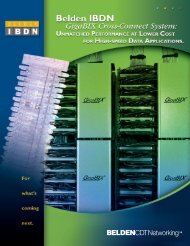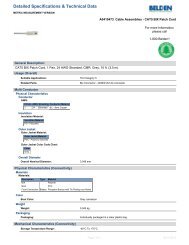PROFINET®,EtherNet/IP, and Ethernet Connectivity Solutions - Belden
PROFINET®,EtherNet/IP, and Ethernet Connectivity Solutions - Belden
PROFINET®,EtherNet/IP, and Ethernet Connectivity Solutions - Belden
Create successful ePaper yourself
Turn your PDF publications into a flip-book with our unique Google optimized e-Paper software.
Industrial <strong>Ethernet</strong> Media<br />
Cordsets, Connectors<br />
<strong>and</strong> Switches with Plug-<br />
N-Play Features Reduce<br />
Overall Installation <strong>and</strong><br />
Maintenance Costs.<br />
6<br />
Introduction to PROFINET, <strong>EtherNet</strong>/<strong>IP</strong> <strong>and</strong> <strong>Ethernet</strong><br />
About Industrial <strong>Ethernet</strong><br />
The use of <strong>Ethernet</strong> in IT for connecting various<br />
terminals is widespread, especially in local area<br />
networks (LAN). Since 1985, the Institute of<br />
Electrical <strong>and</strong> Electronics Engineers (IEEE) has<br />
used the <strong>Ethernet</strong> technology developed by Dr.<br />
Metcalfe as its official st<strong>and</strong>ard (802.3). This<br />
st<strong>and</strong>ard remains the basic technology used in<br />
an effective data transfer system that continues<br />
to be developed (Fast <strong>Ethernet</strong>, 10-Gigabit<br />
<strong>Ethernet</strong>, switching, full duplex data transfer,<br />
wireless LAN).<br />
One St<strong>and</strong>ard, Many Protocols.<br />
Generally speaking, <strong>Ethernet</strong> is also suitable<br />
for automation applications. Nevertheless, the<br />
requirements of industrial communication are<br />
more rigorous with regard to the mechanical<br />
<strong>and</strong> electrical characteristics of the devices <strong>and</strong><br />
media used.<br />
Two examples that can be named here are<br />
ambient conditions <strong>and</strong> real-time behavior.<br />
In addition, no uniform application protocol<br />
exists that is tailored to meet the needs of<br />
automation technology. A host of different<br />
organizations have defined higher application<br />
protocols that can be embedded in the st<strong>and</strong>ard<br />
<strong>Ethernet</strong> data package. As a result, different<br />
protocols <strong>and</strong> specifications are currently in use.<br />
Neither protocols are compatible with<br />
one another:<br />
TCP/<strong>IP</strong> (“Office” <strong>Ethernet</strong> Protocol)<br />
<strong>EtherNet</strong>/<strong>IP</strong> (ODVA)<br />
PROFINET (Profibus user organization)<br />
Modbus/TCP (Modbus-IDA Group)<br />
In addition, other manufacturer-specific<br />
approaches exist such as EtherCat, <strong>Ethernet</strong>-<br />
Powerlink, <strong>and</strong> JetSync. Lumberg Industrial<br />
<strong>Ethernet</strong> products have been designed for<br />
use with TCP/<strong>IP</strong>, <strong>EtherNet</strong>/<strong>IP</strong>, PROFINET, <strong>and</strong><br />
Modbus/TCP systems.<br />
Data Transfer Technology<br />
While there are different approaches to<br />
real-time communication, all of them have a<br />
common core, which comprise the established<br />
st<strong>and</strong>ards of Layers 1-2 as well as the <strong>Ethernet</strong><br />
data transfer technology <strong>and</strong> bus access<br />
procedure (CSMA/CD, Layer 2). All systems<br />
support industrial IT functions such as Web<br />
servers, file transferring, <strong>and</strong> e-mail. For IT<br />
functions such as these, the Internet protocol<br />
(Layer 3) as well as TCP <strong>and</strong> UDP protocol (Layer<br />
4) are used. In addition, other IT st<strong>and</strong>ards can<br />
be used such as Hypertext Transfer Protocol<br />
(http) <strong>and</strong> File Transfer Protocol (FTP).<br />
Carrier Sense Multiple Access with<br />
Collision Detection (CSMA/CD)<br />
MA-Multiple Access All devices in an <strong>Ethernet</strong><br />
network are equal <strong>and</strong> can exchange data with<br />
other devices at any time. Devices access media<br />
together. <strong>Ethernet</strong> does not rely on a master/<br />
slave procedure of the type used with field<br />
busses, where communication is controlled by a<br />
central device.<br />
CS-Carrier Sense<br />
If a device wants to send a data package, it first<br />
checks to see whether the medium is available<br />
or communication is already in progress. If<br />
the medium is busy, the device will wait for<br />
completion of the current data transfer <strong>and</strong> will<br />
only send data when the medium is no<br />
longer busy.<br />
CD-Collision Detection<br />
While sending data, the device monitors the<br />
medium to detect collisions with data packages<br />
sent by other devices. If a collision has been<br />
detected, the devices involved stop sending<br />
data <strong>and</strong> wait for a specific amount of time to<br />
elapse before restarting the sending procedure.<br />
The system assumes that a data package has<br />
been sent successfully if no collisions occur.<br />
In this process, the transfer time depends<br />
greatly on the power supply load <strong>and</strong> cannot<br />
be predetermined. For this reason, this data<br />
transfer procedure is only suitable for certain<br />
types of industrial automation.<br />
The performance of an <strong>Ethernet</strong> network can<br />
be improved through the use of switches <strong>and</strong><br />
<strong>Ethernet</strong> interfaces with full duplex operation.<br />
The CSMA/CD procedure is deactivated during<br />
full duplex device operation (simultaneous data<br />
package sending <strong>and</strong> receiving).<br />
1-717-217-2299 www.lumberg-automationusa.com


